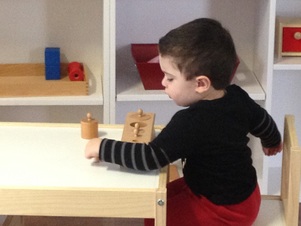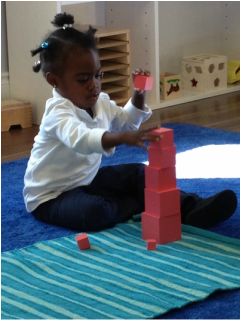Toddler Program

TODDLER PROGRAM – AGES 18 MONTHS - 3 YEARS
Our Toddler Program offers children a natural extension of the home environment. The purpose of the Toddler community is to create a safe environment and the opportunity to develop independence, concentration, and self-esteem. The students are also given the opportunity to master the skills of independent toileting. The natural ability of the child to learn is cultivated with a consistent routine within a secure and orderly setting.
Outdoor exploration is part of the daily routine with the Toddler curriculum. The children will explore our 1 acre yard with activities based around the environment. Gross motor development is concentrated on and practiced while outside, and children develop an appreciation for nature. Children are encouraged to express themselves through their art work and singing and dancing in our bright, airy and spacious Toddler Room. Children are also given an introduction to the Montessori Method and Materials preparing them for the next step as they move on to the Casa Classroom.
The Toddler Room consists of 5 main areas:
1. Practical Life – pouring, spooning, sweeping, locks and keys, etc.
2. Sensorial – introduction to the senses, geometric shapes and discrimination of size, height, etc.
3. Language – vocabulary and articulation enhancement
4. Math – symbol and quantity recognition from 1 to 10
5. Culture – introduction to the continents and Canada, science experiments, and discussions about people, plants and animals of the world.
Upon completion of the Toddler Program, students should be independent in toileting, confident with social interactions, and comfortable with handling everyday tasks.
Casa Program

CASA PROGRAM – CHILDREN AGES 3 - 6 YEARS
Quiet Waters Montessori Academy's Casa program’s name originates from the Italian ‘Casa de Bambini’; a name Dr. Montessori originally gave children within the age group of 2 ½ – 6 years.
Dr. Maria Montessori (1870 – 1952) developed a philosophy of education, which enabled children to develop and learn naturally, through spontaneous and self-directed activities. She recognized that during the first six years of life, children experience a series of “sensitive periods”. Maria Montessori took advantage of these “sensitive periods” by helping the children develop the five senses and assisting them in perfecting these natural learning tools.
The Montessori Classroom is a “mini” community which is child-based and focuses on each individual child. As you enter the classroom you will see that every aspect of the classroom is child-sized and child-focused. The main objective of Quiet Waters Montessori Academy is to create an environment in which children respect the rights of others and feel a responsibility to others, while respecting their own individuality. This will help to prepare the children to responsibly participate in society.
Quiet Waters Montessori Academy's Casa program’s name originates from the Italian ‘Casa de Bambini’; a name Dr. Montessori originally gave children within the age group of 2 ½ – 6 years.
Dr. Maria Montessori (1870 – 1952) developed a philosophy of education, which enabled children to develop and learn naturally, through spontaneous and self-directed activities. She recognized that during the first six years of life, children experience a series of “sensitive periods”. Maria Montessori took advantage of these “sensitive periods” by helping the children develop the five senses and assisting them in perfecting these natural learning tools.
The Montessori Classroom is a “mini” community which is child-based and focuses on each individual child. As you enter the classroom you will see that every aspect of the classroom is child-sized and child-focused. The main objective of Quiet Waters Montessori Academy is to create an environment in which children respect the rights of others and feel a responsibility to others, while respecting their own individuality. This will help to prepare the children to responsibly participate in society.
Objectives of the Casa Program
Casa Materials and Activities
The areas of learning are both academic subjects such as Mathematics, Language, Art and Culture, as well as uniquely Montessori subjects such as Practical Life and Sensorial activities. The materials and activities provided in a Montessori environment are:
1. Practical Life
These materials relate to the care of self, and care of the indoor and outdoor environment. The exercises also enable children to develop independence, concentration, self-esteem, confidence, and co-ordination of movement.
2. Sensorial
The sensorial materials provide the first introduction to the refinement of all senses, discrimination of size, height, width, and breadth dimensions, as well as geometric shapes.
3. Mathematics
Manipulative materials and exercises in this area will help the child to grasp the concepts of numeration, place value, addition, subtraction, multiplication, division and introduce the decimal system.
4. Language Arts
There is verbal integration in all subject areas for the total development of language; from listening to stories, verbally expressing experiences, and creative writing. The students learn to read by developing awareness of sound isolation, and through the use of the Montessori phonetic language system.
5. Culture
Children at the Casa level are very interested in learning about the world that they live in. The Montessori classroom provides information encompassing the subject of botany, science, zoology, geography, history and art.
Along with the regular Montessori program, the children are introduced to:
a) Music
The music program is designed to develop a response to rhythm, tempo, and melodic direction through activities such as group and individual singing, playing of rhythm instruments and dance.
b) Art
The art program is integrated into the regular Montessori exercises. The students learn basic art skills — such as cutting with scissors and pasting — while exploring different textures and materials. Each month children will explore different cultural art, famous artists, traditional art and local artisans will share their ideas with the school.
c) French
The children are introduced to the French language through songs, games, and other fun and interactive activities. In this way, students become aware of a new language and are excited to practice speaking it. New vocabulary is taught using the actual object, which is then touched and felt, and by performing the action described.
d)Physical Education
Students enjoy physical education during outdoor activities in our beautiful playground. Students are also encouraged to participate in organized indoor activities that focus on gross motor activities.
- To allow the student to become active in the process of learning
- To assist the student in developing a strong character and a natural love of learning that will endure throughout his or her life.
- To assist the student in developing adaptability and creativity in learning and living.
- To assist the student in acquiring the fundamental skills needed to communicate, through words, numbers and symbols.
- To allow the student to enjoy and gain satisfaction from sharing various concepts through different forms of artistic expression.
Casa Materials and Activities
The areas of learning are both academic subjects such as Mathematics, Language, Art and Culture, as well as uniquely Montessori subjects such as Practical Life and Sensorial activities. The materials and activities provided in a Montessori environment are:
1. Practical Life
These materials relate to the care of self, and care of the indoor and outdoor environment. The exercises also enable children to develop independence, concentration, self-esteem, confidence, and co-ordination of movement.
2. Sensorial
The sensorial materials provide the first introduction to the refinement of all senses, discrimination of size, height, width, and breadth dimensions, as well as geometric shapes.
3. Mathematics
Manipulative materials and exercises in this area will help the child to grasp the concepts of numeration, place value, addition, subtraction, multiplication, division and introduce the decimal system.
4. Language Arts
There is verbal integration in all subject areas for the total development of language; from listening to stories, verbally expressing experiences, and creative writing. The students learn to read by developing awareness of sound isolation, and through the use of the Montessori phonetic language system.
5. Culture
Children at the Casa level are very interested in learning about the world that they live in. The Montessori classroom provides information encompassing the subject of botany, science, zoology, geography, history and art.
Along with the regular Montessori program, the children are introduced to:
a) Music
The music program is designed to develop a response to rhythm, tempo, and melodic direction through activities such as group and individual singing, playing of rhythm instruments and dance.
b) Art
The art program is integrated into the regular Montessori exercises. The students learn basic art skills — such as cutting with scissors and pasting — while exploring different textures and materials. Each month children will explore different cultural art, famous artists, traditional art and local artisans will share their ideas with the school.
c) French
The children are introduced to the French language through songs, games, and other fun and interactive activities. In this way, students become aware of a new language and are excited to practice speaking it. New vocabulary is taught using the actual object, which is then touched and felt, and by performing the action described.
d)Physical Education
Students enjoy physical education during outdoor activities in our beautiful playground. Students are also encouraged to participate in organized indoor activities that focus on gross motor activities.